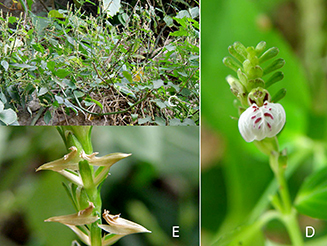A synopsis of Rungia (Acanthaceae) in Thailand
DOI:
https://doi.org/10.20531/tfb.2020.48.1.11Keywords:
Lectotype, new combination, Rungia, taxonomyAbstract
A synopsis of the genus Rungia in Thailand is presented. The 14 species are listed together with a synoptic account of each species and an identification key is provided. Rungia repens is selected as the type of Rungia. One species, Rungia brandisii is a new record for Thailand. Lectotypes are selected for Rungia adnata, R. brandisii, R. diversibracteata, R. maculata, R. rivicola, R. subtilifolia and R. tenuissima. A new combination, Rungia polyneura is made for Justicia polyneura which is found to belong within Rungia based on morphological characters.
Downloads
References
Anderson, T. (1867). An Enumeration of the Indian Species of Acanthaceae. The Journal of the Linnean Society 9: 425–530.
Benoist, R. (1935). Acanthaceae. In: F. Gagnepain (ed.), Flora Générale de L’Indo-Chine 4: 610–772, Masson, Paris.
Craib, W.G. (1914). Contributions to the Flora of Siam Additamenta V. Bulletin Miscellaneous Information, Kew 1914(1): 4–11.
Clark, C.B. (1885). Rungia. In: J.D. Hooker (ed.), Flora of British India 4: 545–550, Reeve & Co., London.
Cramer, L.H. (1998). Rungia. In: M.D. Dassanyake & W.D. Clayton (eds), A Revised Handbook to the Flora of Ceylon 12: 102–106. Amerind Publishing, New Delhi.
Darbyshire, I., Vollesen, K. & Kelbessa, E. (2010). Justicia. In: H.J. Beentje (ed.), Flora of Tropical East Africa part 2: 495–601. The Royal Botanic Gardens, Kew, London.
Hansen, B. (1989a). Justicia and Rungia (Acanthaceae) in the Indo-Chinese Peninsula. In: L.B. Holm-Nielsen (ed.), Tropical forests 201–210, Oxford: Academic Press Limited.
Hansen, B. (1989b). Notes on SE Asian Acanthaceae 1. Nordic Journal of Botany 9: 209–215.
Hu, J.Q., Deng, Y.F. & Daniel, T.F. (2011). Rungia. In: Z.Y. Wu, P.H. Raven & D.Y. Hong (eds), Flora of China 19: 443–447. Science Press, Beijing, China.
Imlay, J.B. (1938). The Taxonomy of the Siamese Acanthaceae. Ph.D. Dissertation. University of Aberdeen, Scotland.
Imlay, J.B. (1939). Contributions to the Flora of Siam Additamenta 51. Bulletin Miscellaneous Information, Kew 1939: 109–150.
Kiel, C.A., Daniel, T.F., Darbyshire, I. & McDade, L.A. (2017). Unraveling relationship in the morphologically diverse and taxonomically challenging “justicioid” lineage (Acanthaceae: Justicieae). Taxon 66(3): 645–674.
Mabberley, D.J. (2017). Mabberley’s Plant-Book: A portable dictionary of plants, their classification and uses 4th edition, Cambridge University Press, New York, 754 pp.
Nees von Esenbeck, C.G.D. (1832). Acanthaceae Indiae Orientalis. In: N. Wallich (ed.), Plantae Asiaticae Rariores 3: 70–117. Treuttel, Würtz and Richter, London.
Nees von Esenbeck, C.G.D. (1847). Acanthaceae. In: A.P. de Candolle (ed.), Prodromus Systemalis Naturalis Regni
Vegetabilis 11: 46–519. Sumptibus Sociorum Treuttel & Würtz, Paris.
Thiers, B. (2019). Index Herbariorum: A global directory of public herbaria and associated staff. New York botanical Garden, New York. Available at http://sweetgum.nybg.org/science/ih/>. accessed 13 Jan. 2019.
Wood, J.R.I. (2001). Rungia. In: A.J.C. Grierson & D.G. Long (eds), Flora of Bhutan 2: 1290–1291. Royal Botanic Garden, Edinburgh & Royal Government of Bhutan.
Wood, J.R.I. (2014). New names and combinations in Indian Acanthaceae. Novon 23(3): 385–395.



